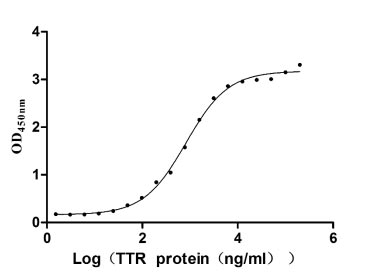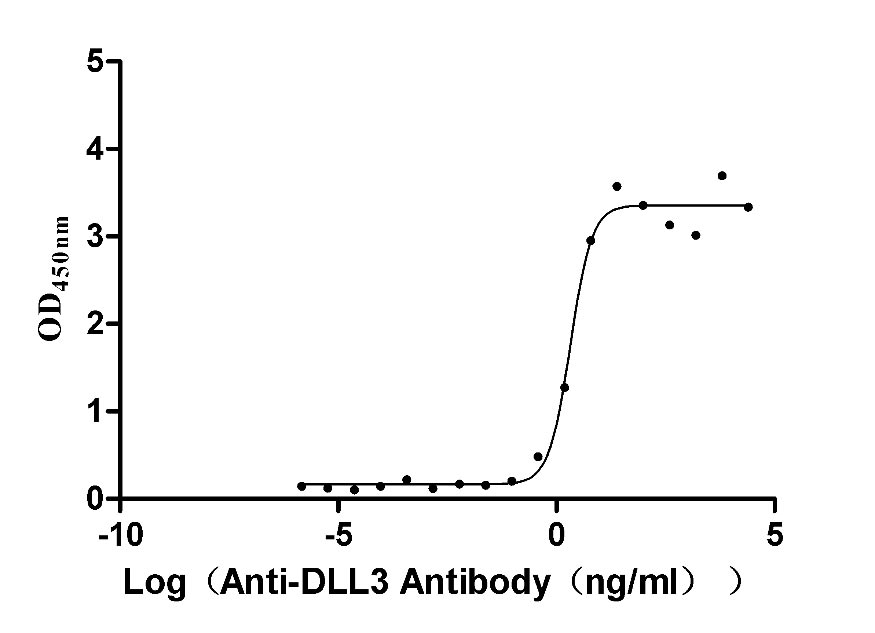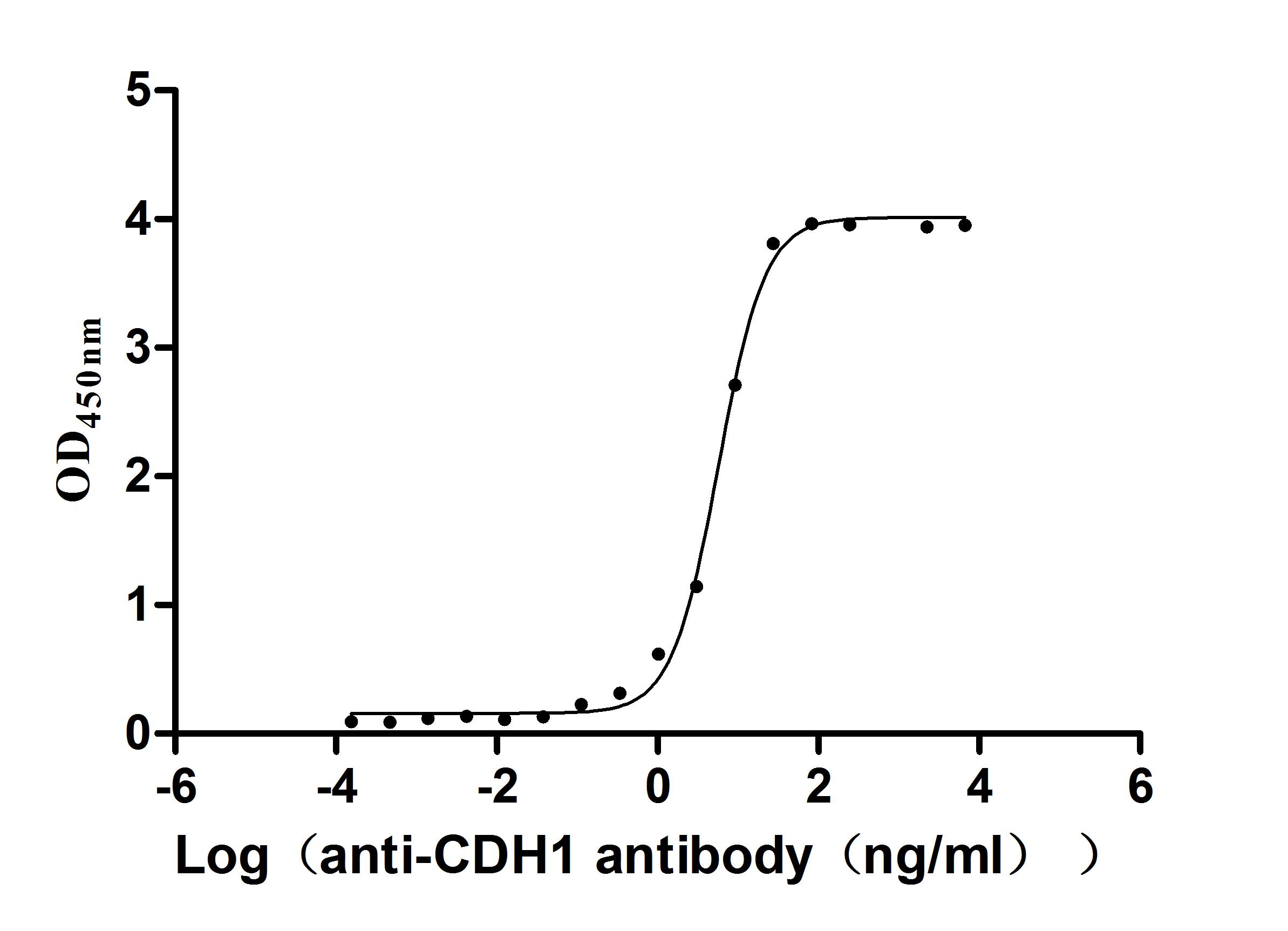Recombinant Human Protein VPRBP (VPRBP), partial
-
货号:CSB-EP896722HU1
-
规格:¥1836
-
图片:
-
其他:
产品详情
-
纯度:Greater than 90% as determined by SDS-PAGE.
-
基因名:DCAF1
-
Uniprot No.:
-
别名:DCAF1; KIAA0800; RIP; VPRBPDDB1- and CUL4-associated factor 1; HIV-1 Vpr-binding protein; VprBP; Serine/threonine-protein kinase VPRBP; EC 2.7.11.1; Vpr-interacting protein
-
种属:Homo sapiens (Human)
-
蛋白长度:Partial
-
来源:E.coli
-
分子量:46.0 kDa
-
表达区域:1045-1396aa
-
氨基酸序列QAPINFTSRLNRRASFPKYGGVDGGCFDRHLIFSRFRPISVFREANEDESGFTCCAFSARERFLMLGTCTGQLKLYNVFSGQEEASYNCHNSAITHLEPSRDGSLLLTSATWSQPLSALWGMKSVFDMKHSFTEDHYVEFSKHSQDRVIGTKGDIAHIYDIQTGNKLLTLFNPDLANNYKRNCATFNPTDDLVLNDGVLWDVRSAQAIHKFDKFNMNISGVFHPNGLEVIINTEIWDLRTFHLLHTVPALDQCRVVFNHTGTVMYGAMLQADDEDDLMEERMKSPFGSSFRTFNATDYKPIATIDVKRNIFDLCTDTKDCYLAVIENQGSMDALNMDTVCRLYEVGRQRLAE
Note: The complete sequence including tag sequence, target protein sequence and linker sequence could be provided upon request. -
蛋白标签:N-terminal 10xHis-tagged
-
产品提供形式:Liquid or Lyophilized powder
Note: We will preferentially ship the format that we have in stock, however, if you have any special requirement for the format, please remark your requirement when placing the order, we will prepare according to your demand. -
缓冲液:If the delivery form is liquid, the default storage buffer is Tris/PBS-based buffer, 5%-50% glycerol. If the delivery form is lyophilized powder, the buffer before lyophilization is Tris/PBS-based buffer, 6% Trehalose.
-
复溶:We recommend that this vial be briefly centrifuged prior to opening to bring the contents to the bottom. Please reconstitute protein in deionized sterile water to a concentration of 0.1-1.0 mg/mL.We recommend to add 5-50% of glycerol (final concentration) and aliquot for long-term storage at -20°C/-80°C. Our default final concentration of glycerol is 50%. Customers could use it as reference.
-
储存条件:Store at -20°C/-80°C upon receipt, aliquoting is necessary for mutiple use. Avoid repeated freeze-thaw cycles.
-
保质期:The shelf life is related to many factors, storage state, buffer ingredients, storage temperature and the stability of the protein itself.
Generally, the shelf life of liquid form is 6 months at -20°C/-80°C. The shelf life of lyophilized form is 12 months at -20°C/-80°C. -
货期:13-23 business days
-
注意事项:Repeated freezing and thawing is not recommended. Store working aliquots at 4°C for up to one week.
-
Datasheet & COA:Please contact us to get it.
相关产品
靶点详情
-
功能:Acts both as a substrate recognition component of E3 ubiquitin-protein ligase complexes and as an atypical serine/threonine-protein kinase, playing key roles in various processes such as cell cycle, telomerase regulation and histone modification. Probable substrate-specific adapter of a DCX (DDB1-CUL4-X-box) E3 ubiquitin-protein ligase complex, named CUL4A-RBX1-DDB1-DCAF1/VPRBP complex, which mediates ubiquitination and proteasome-dependent degradation of proteins such as NF2. Involved in the turnover of methylated proteins: recognizes and binds methylated proteins via its chromo domain, leading to ubiquitination of target proteins by the RBX1-DDB1-DCAF1/VPRBP complex. The CUL4A-RBX1-DDB1-DCAF1/VPRBP complex is also involved in B-cell development: DCAF1 is recruited by RAG1 to ubiquitinate proteins, leading to limit error-prone repair during V(D)J recombination. Also part of the EDVP complex, an E3 ligase complex that mediates ubiquitination of proteins such as TERT, leading to TERT degradation and telomerase inhibition. Also acts as an atypical serine/threonine-protein kinase that specifically mediates phosphorylation of 'Thr-120' of histone H2A (H2AT120ph) in a nucleosomal context, thereby repressing transcription. H2AT120ph is present in the regulatory region of many tumor suppresor genes, down-regulates their transcription and is present at high level in a number of tumors. Involved in JNK-mediated apoptosis during cell competition process via its interaction with LLGL1 and LLGL2.; (Microbial infection) In case of infection by HIV-1 virus, it is recruited by HIV-1 Vpr in order to hijack the CUL4A-RBX1-DDB1-DCAF1/VPRBP function leading to arrest the cell cycle in G2 phase, and also to protect the viral protein from proteasomal degradation by another E3 ubiquitin ligase. The HIV-1 Vpr protein hijacks the CUL4A-RBX1-DDB1-DCAF1/VPRBP complex to promote ubiquitination and degradation of proteins such as TERT and ZIP/ZGPAT.; (Microbial infection) In case of infection by HIV-2 virus, it is recruited by HIV-2 Vpx in order to hijack the CUL4A-RBX1-DDB1-DCAF1/VPRBP function leading to enhanced efficiency of macrophage infection and promotion of the replication of cognate primate lentiviruses in cells of monocyte/macrophage lineage.
-
基因功能参考文献:
- Data suggest that HIV-1 vpr mediates polyubiquitination of HLTF by directly loading it onto C-terminal WD40 domain of DCAF1 in complex the CRL4, an E3 ubiquitin ligase. (vpr = vpr gene product of Human immunodeficiency virus 1; HLTF = human helicase like transcription factor; DCAF1 = human Vpr (HIV-1) binding protein; CRL4 = human E3 ubiquitin ligase CRL4) PMID: 29079575
- The study suggests that DCAF1 is involved in hepatitis C virus (HCV) replication through regulation of miR-122, and thus provides new insights into the interaction between HCV and the host cell. PMID: 29327233
- RNA interference-mediated knockdown of differentially regulated host factors identified Vpr binding protein (VprBP) as proviral host factor because its downregulation inhibited efficient propagation of seasonal influenza A virus. PMID: 28289176
- High VPRBP expression is associated with high-grade serous ovarian cancer. PMID: 28416635
- Together, these results characterize a novel postintegration restriction of HIV-1 replication in monocyte-derived dendritic cells and show that the interaction of Vpr with the DCAF1/DDB1 E3 ubiquitin ligase complex and the yet-to-be-identified host factor might alleviate this restriction by inducing transcription from the viral long terminal repeat. PMID: 28424288
- This study presents the crystal structure of the DDB1-DCAF1-HIV-1-Vpr-uracil-DNA glycosylase (cyclin U) complex. PMID: 27571178
- VprBP transcription was repressed by cellular miRNA-1236, which contributes to HIV-1 restriction in monocytes. miR-1236 inhibitors enhanced translation of VprBP and promoted infection. miR-1236 mimetics suppressed translation of VprBP. PMID: 24932481
- MCM10 is the natural substrate of the Cul4-DDB1[VprBP] E3 ubiquitin ligase whose degradation is regulated by VprBP, but Vpr enhances the proteasomal degradation of MCM10 by interacting with VprBP. PMID: 26032416
- Vpr downregulated APOBEC3G through Vpr-binding protein (VprBP)-mediated proteasomal degradation, and further confirmed that the reduction of APOBEC3G encapsidation associated with Vpr was due to Vpr's degradation-inducing activity. PMID: 25200749
- Vpr and Vpx share a highly similar DCAF1-binding motif, they interact with a different set of residues in DCAF1. PMID: 25499532
- VprBP, but not DDB1, directly binds to TET2-catalytic domain. PMID: 25557551
- CD44 cytoplasmic tail cleaved by RIP could release DCAF1 from merlin by competing for binding to the merlin FERM domain, which results in the inhibition of merlin-mediated suppression of tumorigenesis. PMID: 24912773
- The identification of Vpr mutants which associate with DCAF1 but only poorly with DDB1 suggests that DCAF1 is necessary but is not sufficient for the Vpr association with DDB1-containing E3 ligase complex. PMID: 24912982
- Data indicate that DCAF1 protein folds into a beta-hairpin structure and binds to the F3 lobe of neurofibromin 2 (Merlin) FERM domain. PMID: 24706749
- The predicted beta-propeller conformation of DCAF1 is likely to be critical for Vpr association. PMID: 24558487
- Our findings establish VprBP as a major kinase responsible for H2AT120p in cancer cells and suggest that VprBP inhibition could be a new strategy for the development of anticancer therapeutics. PMID: 24140421
- the crystal structure of a ternary complex of Vpx with the human E3 ligase substrate adaptor DCAF1 and the carboxy-terminal region of human SAMHD1 PMID: 24336198
- As a molecular adaptor, Vpr enhanced the interaction between TERT and the VPRBP substrate receptor of the DYRK2-associated EDD-DDB1-VPRBP E3 ligase complex, resulting in increased ubiquitination of TERT. PMID: 23612978
- Promoter-localized deacetylation of H3 tails is a prerequisite for VprBP to tether and act as a bona fide inhibitor at p53 target genes. PMID: 22184063
- This review focuses on Vpr and its HIV2/SIV counterparts, Vpx and Vpr, which all engage the DDB1.Cullin4 ubiquitin ligase complex through the DCAF1 adaptor protein. PMID: 20347598
- Study concludes that Merlin suppresses tumorigenesis by translocating to the nucleus to inhibit CRL4(DCAF1). PMID: 20178741
- demonstration that a novel human gene, KIAA0800, is preferentially expressed in the testis and is transactivated by Sox9 PMID: 12111997
- Hence, this chimeric peptide (TEAM-VP) constitutes the first example of a virus-derived mitochondriotoxic compound as a candidate to kill selectively tumor neo-endothelia. PMID: 16888644
- Recruitment of cytoplasmic protein Vpr binding protein (VprBP) by HIV-1 regulatory protein Vpr is essential for its cytostatic activity. PMID: 17314515
- The Cul4-DDB1[VprBP] E3 ubiquitin ligase complex is identified as the downstream effector of lentiviral Vpr for the induction of cell cycle arrest in G2 phase. PMID: 17609381
- Anti-tumor activity mediated by protein and peptide transduction of HIV viral protein R is reported. PMID: 19029839
显示更多
收起更多
-
亚细胞定位:Cytoplasm. Nucleus. Note=Associated with chromatin in a DDB1-independent and cell cycle-dependent manner: recruited to chromatin as DNA is being replicated and is released from chromatin before mitosis.
-
蛋白家族:VPRBP/DCAF1 family
-
组织特异性:Ubiquitously expressed.
-
数据库链接:
HGNC: 30911
KEGG: hsa:9730
STRING: 9606.ENSP00000393183
UniGene: Hs.716623
Most popular with customers
-
Recombinant Human Retinol-binding protein 4 (RBP4) (Active)
Express system: Mammalian cell
Species: Homo sapiens (Human)
-
Recombinant Macaca fascicularis Delta-like protein 3 (DLL3), partial (Active)
Express system: Mammalian cell
Species: Macaca fascicularis (Crab-eating macaque) (Cynomolgus monkey)
-
Recombinant Human Claudin-18.2 (CLDN18.2)-VLPs (Active)
Express system: Mammalian cell
Species: Homo sapiens (Human)
-
Recombinant Human Trophoblast glycoprotein (TPBG), partial (Active)
Express system: Mammalian cell
Species: Homo sapiens (Human)
-
Recombinant Human C-C chemokine receptor type 8 (CCR8)-VLPs (Active)
Express system: Mammalian cell
Species: Homo sapiens (Human)
-
Recombinant Human Cadherin-17 (CDH17), partial (Active)
Express system: Mammalian cell
Species: Homo sapiens (Human)
-
Recombinant Human Cadherin-1(CDH1),partial (Active)
Express system: Mammalian cell
Species: Homo sapiens (Human)
-
Express system: Mammalian cell
Species: Macaca mulatta (Rhesus macaque)





-AC1.jpg)















